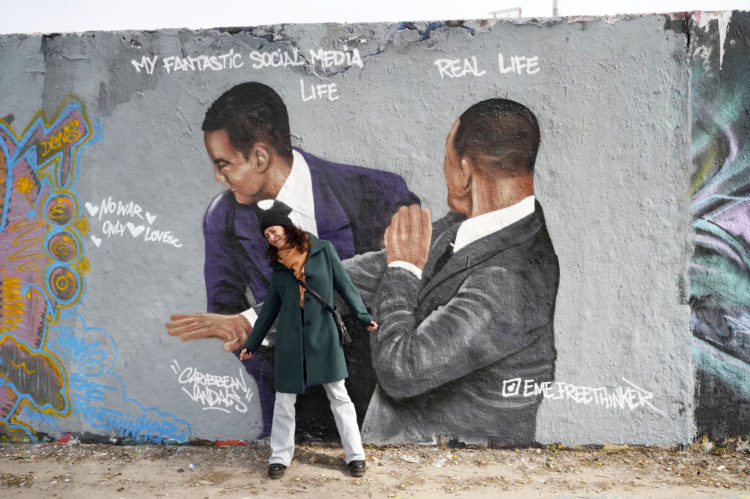| No surprise that the infamous slap during the March 27 Oscars was the talk of the press the next day, and the day after, and so many of the days that followed. No real surprise that someone in he media, within moments, had labeled it the Slap Heard ‘Round the World. Clever? Maybe. Until you wonder if anyone heard it in Ukraine, where the sounds of assault must be shouting out anything else.
That’s not to dismiss the painful debates and thoughtful discussions prompted by Will Smith’s assault on Oscar emcee and comedian Chris Rock. But I had nothing but reactive opinion to add and, frankly, limited interest in celebrity drama. I leave it to people who know more or care more to comment dissect the importance of Hollywood royalty acting anything but princely.
Then Sally Jenkins weighed in — and I was drawn back in, thinking about the assault and its aftermath in new ways. Jenkins, a sports columnist and feature writer for The Washington Post, is just that good. There was nothing derivative about her take. Instead, she dove into Will Smith’s Oscar-winning performance in “King Richard,” and who was given short shrift or missing altogether in the movie about his guidance of tennis greats Venus and Serena Williams: Pretty much everyone but Dad Richard Williams himself.
Stories are wondrous things that also can be dangerous. The more wondrous the story, the more dangerous.
l’ve always wondered about biopics in that context. In the hands of a feature film director, aka multi-dimensional storyteller, they are the kind of compelling that makes you want to believe. The danger of that, of course, is that our view of history, and even current events, can be seriously distorted. That was driven home a few years ago when one of my journalism students said he knew, without doubt, there was a CIA conspiracy to assassinate President John F. Kennedy. When I asked how he knew, he said he had seen Oliver Stone’s “JFK” — not Stone’s 2021 documentary, but his 1991 drama starring Kevin Costner as the New Orleans prosecutor who pushed a narrative about CIA involvement. It’s a theory that probably never will be proven, but that has endured for more than 30 years. This from a 2021 story by Ann Hornaday of the Washington Post about the lasting impact of the original biopic:
Stone took care to distinguish his most purely speculative sequences in a film populated by unreliable narrators, flawed memories and competing versions of the truth. But “JFK’s” images were so convincing, and infiltrated viewers’ imaginations so thoroughly, that the film morphed from one filmmaker’s alternative interpretation of events into the events themselves. Storytelling was internalized as public memory, which itself became a form of consensus history.
Inspiration vs seduction
When I slump into a few hours of Hollywood distraction, I place a big mental asterisk next to the title qualifier “based on a true story.” I put three next to “Inspired by a true story.” It doesn’t undermine my enjoyment. If anything, it inspires me to want to know more.
But how many people do you think plow into even minimal fact-based research about a character after seeing a film? Some smart Googling is mere key taps away. I sometimes think of it as being wowed by the entry hall of an elegant mansion, then being handed the master key to all the other rooms — some enchanting, some shabby. I can choose to stay in wow-land, sipping bubbles. Or I can go exploring. I may be disappointed by some of what I discover — who likes the romance ruined? But often I find even greater levels of wow, which for me often come expressed as “Who knew?” and remind me to back up my conclusions with reporting.
I thought of this recently when a friend and I watched the 2006 film “Glory Road,” directed by James Gartner. It follows the 1966 season of the unlikeliest of Cinderella teams, the Texas Western Miners, as they rise from the sub-basement to win the NCAA men’s college basketball final. The foil: Adolph Rupp’s dynastic University of Kentucky Wildcats. My friend and I were all in. She comes from a basketball family. I was at Marquette University during Coach Al McGuire’s time, when Kentucky was often the rival at the gate, and was not inclined to think well of Rupp. Seeing him portrayed as an arrogant bully and belligerent racist validated my leanings. In the dazzling upset, Kentucky had no Black players; Texas Western started five. Oh happy day!
Then, post-movie, we danced a few steps through Google. The true story is, duh, far more complicated. No simple and singular villain to revile, but an entire culture to confront. And that’s the point. The movie drew us in; our research after poked us to discuss and reconsider, not just the narratives we grew up with, but our own attachment to preferred narratives.
The challenge of narrative nonfiction
Sally Jenkins’ column about the Oscar kerfuffle, or whatever it’s best called, brings the same caution to what we take from Will Smith’s portrayal in “King Richard” and how he linked that to his Oscar acceptance speech. The movie and Smith’s post-slap self-defense are, like all stories, framed. And frames, by their nature, are limited. It doesn’t mean what’s inside them isn’t true, but seldom is it the whole truth.
That’s a challenge for narrative journalists, who use compelling storytelling techniques to try to tell true stories. It’s why we hold transparency so dear.
But it’s also a challenge for story consumers — especially those who aren’t considering the origins of the stories they read, see and believe, and who forget to use asterisks. |

